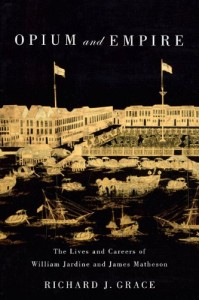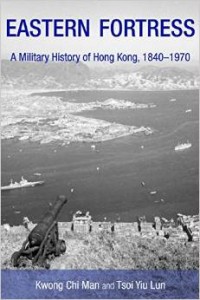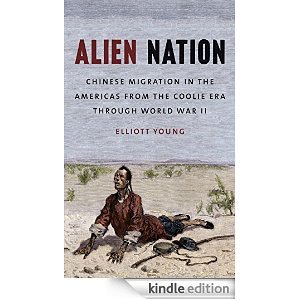Posted: November 22nd, 2014 | No Comments »
Richard Grace’s Opium and Empire covers much ground we may be familiar with but a closer examination of the men behind the “countryman” opium trade, Old Rat with Iron Head and Matheson and their inter-relationship sounds might interesting…

In 1832 William Jardine and James Matheson established what would become the greatest British trading company in East Asia in the nineteenth century. After the termination of the East India Company’s monopoly in the tea trade, Jardine, Matheson & Company’s aggressive marketing strategies concentrated on the export of teas and the import of opium, sold offshore to Chinese smugglers. Jardine and Matheson, recognized as giants on the scene at Macao, Canton, and Hong Kong, have often been depicted as one-dimensional villains whose opium commerce was ruthless and whose imperial drive was insatiable. In Opium and Empire, Richard Grace explores the depths of each man, their complicated and sometimes inconsistent internal workings, and their achievements and failures. He details their decades-long journeys between Britain and China, their business strategies and standards of conduct, and their inventiveness as “gentlemanly capitalists.” The commodities they marketed also included cotton, rice, textile goods, and silks and they functioned as agents for clients in India, Britain, Singapore, and Australia. During the First Opium War Jardine was in London giving advice to Lord Palmerston, while Matheson was detained under house arrest at Canton in the spring of 1839, an incident which helped prompt the armed British response. Moving beyond the caricatures of earlier accounts, Opium and Empire tells the story of two Scotsmen whose lives reveal a great deal about the type of tough-minded men who expanded the global markets of Victorian Britain and played major roles in changing the course of modern history in East Asia.
Posted: November 21st, 2014 | No Comments »
James Hadley Chase (1906-1985) was a truly prolific thriller writer – publishing over 90 novels across his long career. The son of an Indian Army Officer he was born in London and later lived in France and Switzerland. The American hard boiled style appealed and he conjured his own noirish USA through reading writers like James M Cain. His best book, in my opinion was certainly his debut novel No Orchids for Miss Blandish (1939), which became an odd piece of British noir film cinema later. The rather un-PC named 12 Chinks and a Woman was published in 1941 (his third novel), though was later renamed 12 Chinamen and a Woman and then later still, in the 1970s, The Doll’s Bad News.
Here’s the original blurb…
TWELVE CHINAMEN IN A BOAT: Who hadn’t seen a woman in six weeks and were rapidly approaching the pleasure-coast of Florida.
GLORIE LEADLER: A bewitching blonde who seasoned her amorous escapades with the spice of life — variety.
DETECTIVE DAVE FENNER: Whose calloused Broadway heart developed an unsuspected tender emotion when Glorie paid a surprise visit to his bedroom.
PIO CARLOS: A smooth young man from Cuba who thought that he had found a key to Glorie’s heart, when he really held only the key to his own tomb.
NIGHTINGALE: A wily nightbird who let a burly .45 do his talking for him.
If you like your romance supercharged, with no sidetracks or local stops for a breather, climb aboard this Special by the author of “The Villain and the Virgin” and get set for romance and thrills unlimited.
NOT FOR THE TIMID READER!
Only one man could satisfy Glorie Leadler’s craving for love and excitement. And though this golden-haired bit of feminine dynamite could have had a dozen men at her feet for the asking, it was a solitary Oriental who made her heart beat fast. When jealous rivals tore that midnight lover from Glorie’s arms, her overheated emotions burst forth in a volcano of love-stricken vengeance that rocked Florida and left a sizzling mark on many men’s souls.
If you like a combination of the passionate writing of Donald Henderson Clarke and the violence and vigor of Dashiell Hammett you’ll go for this great James Hadley Chase novel. Author of NO ORCHIDS FOR MISS BLANDISH, Chase is a master of mixing hard men, soft ladies, and the shocking impact of unexpected action. TWELVE CHINKS AND A WOMAN is a book we guarantee you won’t lay down until the last thrill-packed page.






Posted: November 20th, 2014 | No Comments »
Chi Man Kwong’s Eastern Fortress looks like a good overview of Hong Kong’s role as a militarily strategic post….

Celebrated as a trading port, Hong Kong was also Britain’s “eastern fortress.” Likened by many to Gibraltar and Malta, the colony was a vital but vulnerable link in imperial strategy, exposed to a succession of enemies in a turbulent age and a troubled region. This book examines Hong Kong’s developing role in the Victorian imperial defence system, the emerging challenges from Russia, France, the USA, Germany, Japan and other powers, and preparations in the years leading up to World War II. A detailed chapter offers new interpretations of the Battle of Hong Kong of 1941, when the colony succumbed to the Japanese invasion. The remaining chapters discuss Hong Kong’s changing strategic role during the Cold War and the winding down of the military presence. The book focuses on policies and events, but also explores the social life of the garrison in Hong Kong, the struggles between military and civil authorities, and relations between armed forces and civilians. Drawing on original research in archives around the world, including English, Japanese, and Chinese sources, this is the first full-length study of the defence of Hong Kong from the beginning of the colonial period to the end of British military interests East of Suez in 1970. Illustrated with photographs and detailed maps, Eastern Fortress will be of interest both to students of history and to the general reader.
Posted: November 19th, 2014 | No Comments »
This picture is of the house of Harry E. Francis which was at 27 Broadmoor Avenue in Colorado. The house was built in 1924 with 4 bedrooms on its own lot. Quite who Harry Francis was I do not know but presumably he had made a fair bit of money in some business or other. A local Colorado photographer called Guy G Burgess took this photo of one of the bedrooms which had a distinctly Chinoiserie taste – not perhaps overly popular in Colorado in the 1920s. The most interesting thing to notice is the oriental flower motif across the entire ceiling as well as the night table which is clearly Chinoiserie and has “Oolong” painted across it. A lovely bedroom to be sure….

Posted: November 18th, 2014 | No Comments »
I’ve blogged a couple of times before regarding Sir Victor Sassoon’s Ciro’s nightclub (here and here) that once stood at 444 Bubbling Well Road, now the stunningly bland Ciro’s Plaza which defies any attempt to be remotely interesting with great strength. Should you have gone to the real nightclub, one of the city’s fanciest in the 1930s (and not sat in the dreary Costa Coffee that stands there today) you could have danced with a beautiful partner, providing you purchased a ticket of course….

Posted: November 17th, 2014 | No Comments »
Elliott Young’s Alien Nation traces Chinese emigration to the US from the 1840s to WW2….

In this sweeping work, Elliott Young traces the pivotal century of Chinese migration to the Americas, beginning with the 1840s at the start of the “coolie” trade and ending during World War II. The Chinese came as laborers, streaming across borders legally and illegally and working jobs few others wanted, from constructing railroads in California to harvesting sugar cane in Cuba. Though nations were built in part from their labor, Young argues that they were the first group of migrants to bear the stigma of being “alien.” Being neither black nor white and existing outside of the nineteenth century Western norms of sexuality and gender, the Chinese were viewed as permanent outsiders, culturally and legally. It was their presence that hastened the creation of immigration bureaucracies charged with capture, imprisonment, and deportation.
This book is the first transnational history of Chinese migration to the Americas. By focusing on the fluidity and complexity of border crossings throughout the Western Hemisphere, Young shows us how Chinese migrants constructed alternative communities and identities through these transnational pathways.
Posted: November 16th, 2014 | 2 Comments »
Recently read the excellent history of Kim Philby by Ben Macintyre, A Spy Among Friends: Kim Philby and the Great Betrayal. There was one China-related anecdote I hadn’t heard before…
Fellow Cambridge spy Guy Burgess (below) had already been forced to flee to Moscow. By the time Philby arrived as a defector in 1963 Burgess had descended into an alcoholic stupour, fallen out with his fellow Moscow-residing spy Donald Maclean and was generally an embarrassment to the KGB. Maclean and Burgess had understandably both been close when they first arrived in Moscow eleven years before in 1951. But they ahd fallen out when Burgess had apparently got so drunk at a reception at the Chinese embassy in Moscow and decided, in full view of everyone, to urinate in the embassy’s fireplace. This went down about as well then as it would now and Burgess was shunned by most diplomats. Philby never got to see Burgess in Moscow – he claimed his Soviet handlers prevented them from meeting due to Burgess’s severe disappointment with the reality of the communist state. Burgess died of liver failure in Moscow in 1963 leaving Philby his collection of 4,000 books meaning Kim at least had some reading for the long drab Soviet nights of exile.

I’m afraid I don’t know if the Chinese embassy Burgess embarassed himself in was the same building as it had been in the 1940s, but I’m going to assume that it was…here then is a picture from 1946 of Jang Jing-guo (to the right), Chiang Kai-shek’s son (and future leader of Taiwan) in the Chinese embassy (then still the ROC embassy obviously) in Moscow. Behind them is a mantelpiece and fireplace with framed pictures of Cordell Hull (The US Secretary of State) and the Generalissimo. However, whether or not this is the fireplace into which Guy Burgess was later to deposit the contents of his full bladder I cannot confirm….(more on the picture and its history here by the way)

Posted: November 15th, 2014 | No Comments »
A classic of the post WW1 London drugs underworld, opium an Yellow Peril, Cocaine from 1922, is now available on the BFI Player for a good honest quid a show….


In this decadent tale of drugs and the London underworld the cosseted daughter of a respectable businessman – in fact head of a cocaine racket – succumbs to the pleasures of drink and drugs. Vivid nightlife scenes recreate the interwar world of flappers and hedonists; the dapper club owner and seedy street dealer are both Chinese (played by white actors), common stereotypes at the time.
The third Chinese character, a sympathetic lackey, is played by an uncredited Chinese actor; his natural performance points up the hamminess of the other two. Retitled While London Sleeps following censorship problems, Cocaine was the directorial debut of Graham Cutts, a prominent figure in 1920s and 30s British cinema and a mentor (and later rival) to the young Alfred Hitchcock.














